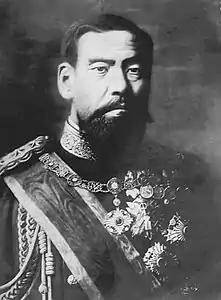Dai-gensui
The Supreme Commander-in-chief of the Imperial Japanese Army and Navy (Japanese: 大元帥陸海軍大将, romanized: Dai-gensui-riku-kai-gun-taishō) was the highest rank of the Imperial Japanese Army and the Imperial Japanese Navy from the 1870s to 1945, when the Empire of Japan was dissolved. The rank was only ever held by the Emperor of Japan as commander-in-chief of the Empire's Armed Forces and, separately, the highest-ranking officer in each of the Armed Services. It formally became obsolete in 1947 when the Imperial Japanese armed forces were abolished.
History
The term originated in the Chinese military title da yuan shuai (大元帥), a title higher than yuan shuai (元帥, pronounced gensui in Japanese).
Decree No. 252 by the Dajokan, dated 7 September 1872 first made formal mention of the rank of dai-gensui; however, no appointments to the rank were made before the rank was abolished along with that of gensui on 8 May 1873. By "Draft Ordinance No. 142" of the Constitution of the Empire of Japan (Chapter 1 Part 1) of 30 September 1889, the Emperor was officially given the rank of dai-gensui and installed as supreme commander of the Army and Navy.
The kanji characters also refer to a Buddhist deity, Daigensui Myō'ō (大元帥明王), a Wisdom King worshipped by the Imperial Court since Emperor Ninmyō and by the Shingon sect, for its legendary miraculous power to quell foreign enemies and rebellions, just like a military leader.
Insignia
The insignia of a dai-gensui were identical to those of a full general, with the addition of the gold imperial chrysanthemum.
.png.webp) Army collar insignia
Army collar insignia.png.webp) Army shoulder insignia
Army shoulder insignia Naval shoulder insignia
Naval shoulder insignia Naval collar insignia
Naval collar insignia Naval sleeve insignia
Naval sleeve insignia
List of holders
| Portrait | Name (birth–death) |
Term of office | Ref. | ||
|---|---|---|---|---|---|
| Took office | Left office | Time in office | |||
 |
Meiji Emperor (1852–1912) |
1872 1889 |
1873 30 July 1912 † |
23–24 years | |
.jpg.webp) |
Taishō Emperor (1879–1926) |
30 July 1912 | 25 December 1926 † | 13–14 years | |
 |
Shōwa Emperor (1901–1989) |
25 December 1926 | 2 September 1945 | 18–19 years | |
See also
- Other pronunciations of the characters 大元帥
- Da yuan shuai in Chinese
- Taewonsu, the Korean equivalent
- The higher rank of gensui (元帥)
- Yuan shuai, the original Chinese title
- Wonsu, the Korean equivalent
References
- This article incorporates information from the corresponding article in the Japanese Wikipedia.
- Donald Keene, Emperor of Japan, Meiji and his World 1852–1912